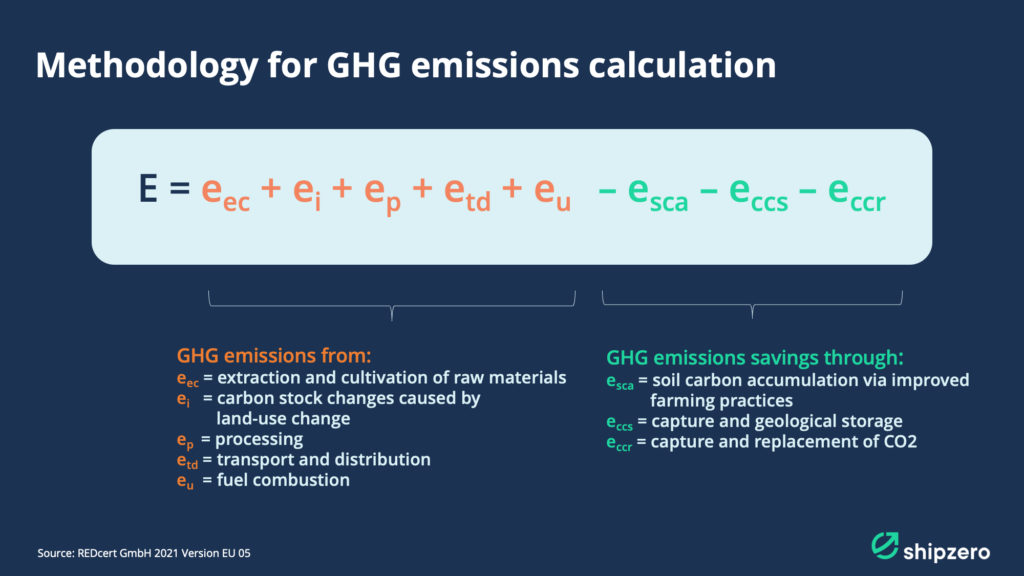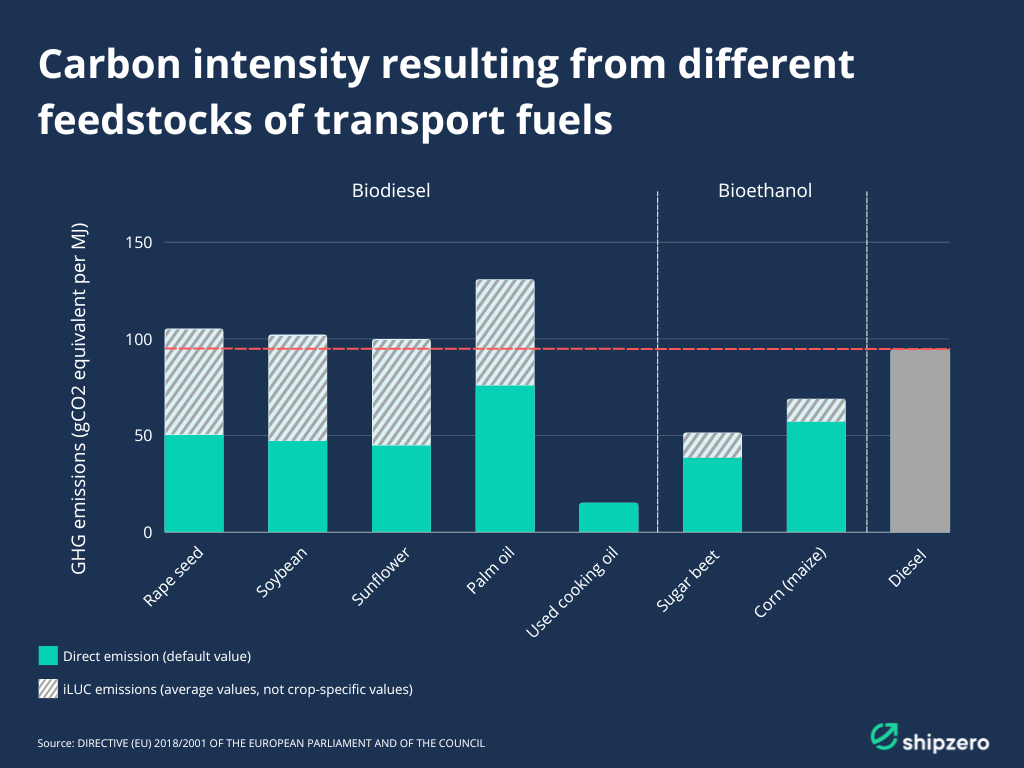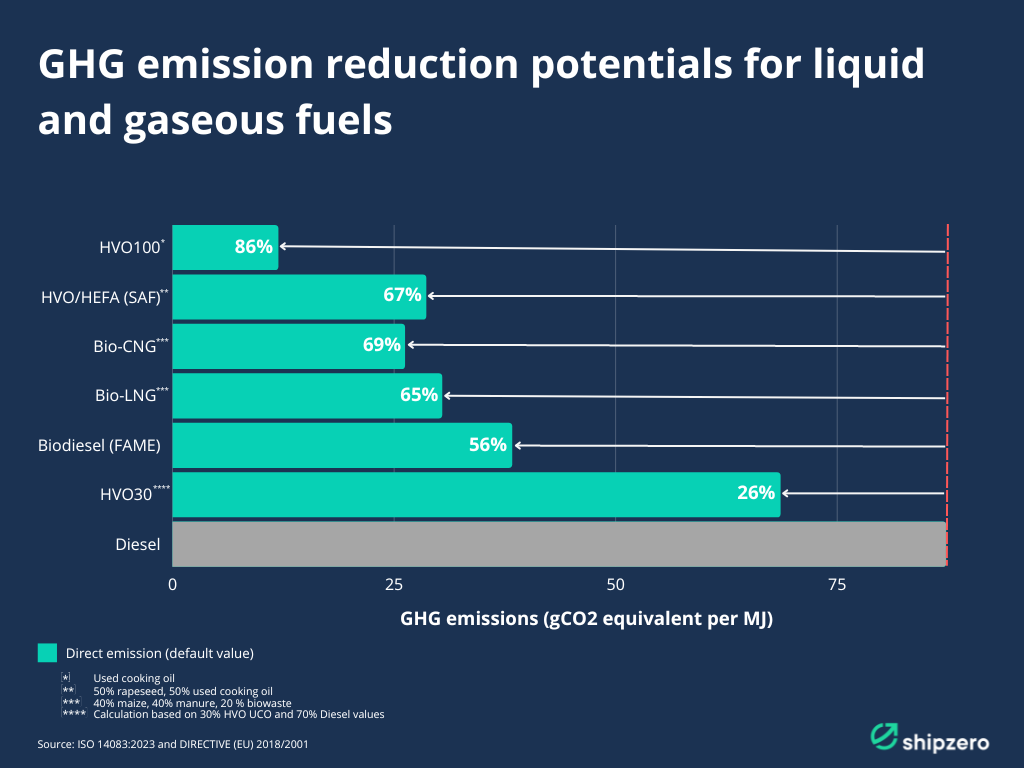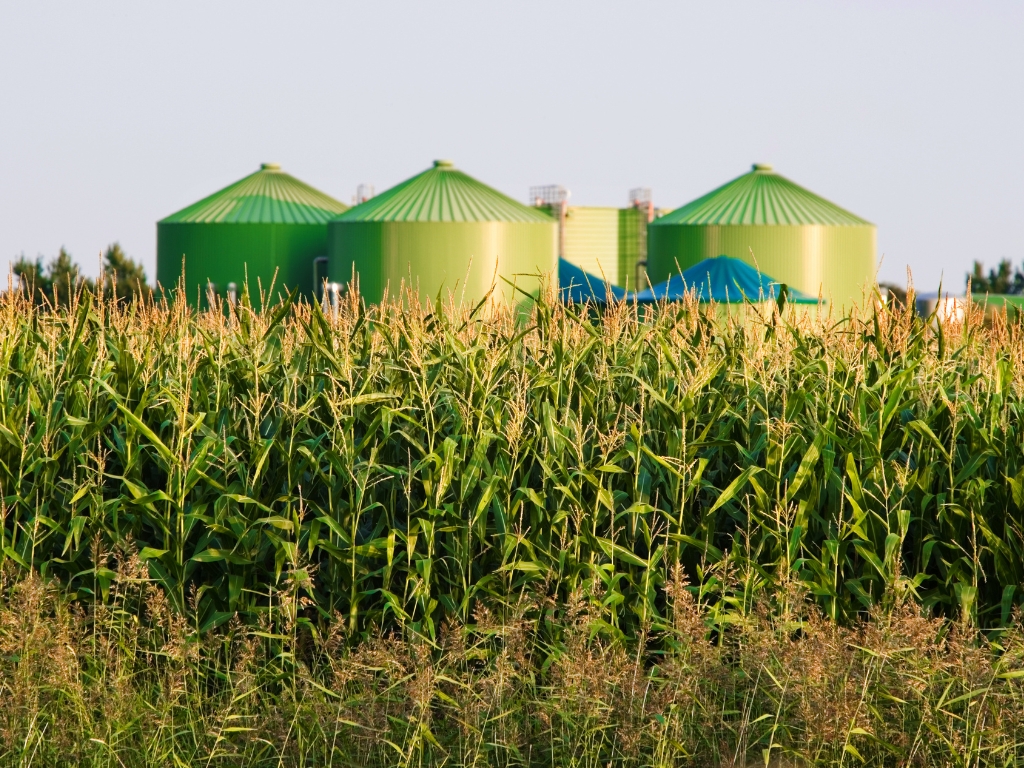Effective action is needed to reduce greenhouse gas (GHG) emissions from road transport, given the Green Deal objective of decarbonization. While other technologies such as battery electric trucks (BET) or fuel cell electric trucks (FCET) still need major development and investment to ensure sufficient long-term coverage, biofuels emerged as the promising alternative to fossil fuels. Alongside the projected reduction potentials, biofuel infrastructures have the advantage of being relatively easy to expand and holding the possibility of leveraging existing diesel infrastructure. This is why biofuels are currently regarded as a prompt solution for the global freight industry’s quest for decarbonization. In the first part of this blog series, we introduced biofuels’ potential to reduce carbon emissions. In this second part, we delve deeper into the calculations and factors that determine biofuels’ carbon reduction potential.
Calculation and greenhouse gas reduction
Biofuels are intended to contribute significantly to the decarbonization of freight transportation by emitting as few GHG as possible. In order to create comparability with conventional fuels, a standardized calculation logic is required that includes relevant production steps and their respective effects. The renewable energy directive II (RED) established the methodology for calculating lifecycle emissions from the production and use of biofuels as the sum of disaggregated emissions of each component of the supply chain. This also includes feedstock production and potential emissions from carbon stock changes caused by direct land-use change [1].

To understand the true impact of the emission intensity of individual biofuels, each e value will need to be determined to indicate E, the total emissions in gCO2e/MJ. Each interface, plant, and site calculates the cumulative GHG emissions of biomass production and delivery up to its/their operation before it is transferred to downstream interfaces, operations, and sites.
When compared to fossil fuels, biofuels offer significant emission reductions, as indicated by default values for both first and second generation biofuels. For instance, rapeseed biodiesel shows a reduction potential of 43% compared to the commonly used fossil fuel comparator of 94 g CO2eq/MJ, with a value of 50,1 CO2eq/MJ. Waste cooking oil biodiesel has an even lower value of 14,9 CO2eq/MJ, which represents a GHG emission reduction of almost 85% [2].
Relevance of the calculational approach
However, this substantial difference in emissions should be celebrated with caution, since the calculation results given exclude a controversial factor that is not insignificant in the case of first-generation fuels. The ei factor, referring to indirect land use change.
Indirect land-use change occurs when the production or use of alternative fuels causes food and feed production at home or abroad to be displaced. This displacement happens due to price effects or competition for land. As a result, the production or use of alternative fuels forces food and feed production to move to other, previously unused land, thus causing direct land-use change (dLUC), which in turn can have negative, but also positive, environmental, and social consequences that are indirectly attributable to the production or use of the alternative fuels. Unfortunately, it is not easy or essentially impossible to determine who causes iLUC and to separate it from dLUC. The process of disentangling these factors is purely theoretical in nature. In reality, numerous simultaneous changes occur, further complicating the identification of price effects. Factors such as fluctuating supply, rising demand driven by population and income growth, improvements in productivity, and a multitude of other effects are all unfolding concurrently.

Due to the difficulty of reproducing these factors, the reporting requirements of RED II set an average of 12 g CO2eq/MJ for cereals and other crops with high starch content, 13 g CO2eq/MJ for sugar crops and 55 g CO2eq/MJ for oil crops, respectively, in accordance with Annex VIII. However, when iLUC factors are taken into account, it becomes evident that meeting the EU GHG reduction targets of at least 50% set since 2018 is unattainable. In fact, these targets surpass the calculated emissions from fossil diesel, even when just considering average values [3]. The challenges posed by the non-standardized calculation and reporting requirements of iLUC can potentially lead to the improvement of sustainable fuel production pathways through a scientifically grounded and differentiated approach.
Advanced biofuels – developments and challenges
Expanding biofuel production to advanced feedstocks is crucial for minimizing the impact on land use, food prices, and the environment. In the Net Zero Scenario, it is projected that biofuels derived from wastes, residues, and dedicated crops that do not compete with food crops will make up approximately 50% of biofuel consumption by 2030. This represents a substantial increase from the estimated 8% in 2021 [4].
In recent years, there has been significant progress in the biofuels sector, which can be seen both in the varieties offered and in the blending ratios. Notably, waste-based liquid fuels can be blended with both fossil and biogenic fuels, resulting in different compositions along with emission reduction potentials. Although the expansion of production capacities for waste-based alternative fuels is still at an early stage, owing to natural limitations in availability and infrastructure, the so-called “drop-in capability” enables the immediate use of even small available quantities. This enables an immediate reduction in GHG emissions, which can then be gradually increased as the share of alternative fuels grows.

The fuels listed in Annex IX, Part B, have a special role to play in meeting RED II targets in the transport sector. These include biofuels based on used cooking oil (UCO) and biofuels based on animal fats of categories 1 and 2 of Regulation (EC) No 1069/20091.
These fuels achieve high greenhouse gas savings and have low iLUC risks. However, RED II sets a cap of 1.7% for the fuels listed in Annex IX, Part B, yet indicates that higher percentages may be allowed at the request of a member state with appropriate justification. Unlike conventional biofuels, the cap imposed on fuels listed in Annex IX Part B is not motivated by environmental concerns. On the contrary, it aims to address limited capacities within the EU, high demands from non-EU regions, and most importantly, prevent the depletion of these valuable residues from third countries. Simultaneously to the existence of the cap, the EU provided incentives for the production of biodiesel made with waste oils and fat. However, at present less than 20% of the raw materials listed in Annex IX Part B are sourced from within Europe, while a considerable proportion is increasingly being imported from Southeast Asian countries [5]. This situation raises challenges regarding the traceability of the origin and ensuring the sustainability of the derived fuel in global supply chains.
Just recently, the EU Commission addressed the challenge of monitoring biodiesel imports declared as waste-based from China, which have seen a drastic increase of 80% to 300,000 metric tons in January and February 2023 compared to the same period in 2022. This surge has prompted EU producers to sharply reduce production, causing disruptions in European factories, as reported by the European Waste-based Advanced Biofuels Association (EWABA) [6]. The volume of fuel imported from China has raised concerns that imported biodiesel is not being produced from legitimate waste sources, but from cheaper, limited feedstocks such as palm oil [7].
In light of these developments, there is a pressing need for a global, sound auditing and monitoring mechanism to ensure the sustainability of waste-based and advanced biodiesel, preventing fraudulent activities and ensuring the integrity of the biofuel industry.
Outlook
Overall, the potential of advanced biofuels to contribute to decarbonizing the transport sector and reducing greenhouse gas emissions is significant, despite the challenges involved. However, the realization of this potential depends greatly on the specific framework conditions and raw material sources. Taking a closer look at the current biofuel market reveals how much the achievement of the Fit for 55 package depends on the different orientations of individual sectors, capacities within the EU as well as political regulations. When the overall goal of climate neutrality is considered in silos, it is jeopardized by different measures that complicate, if not exclude, each other. To attain the highest level of decarbonization in the transport sector, it is crucial to efficiently utilize regional feedstocks and limited availability waste oils, creating a win-win situation for all modes of transportation. While the transport industry aims to reduce its climate impact, it is important to ensure that fast-to-implement solutions align with the objective of achieving higher decarbonization. For instance, using biofuels at waste collection sites can have a more positive overall climate effect compared to fuel-intensive transport to European consumers. In this context, concepts like book and claim can be relevant and aligned with these considerations (see blog entry).
In the quest to decarbonize one of the most vital sectors, it is evident that a few quick-fix solutions alone will not suffice. Recent years have exposed how the initial political enthusiasm for biofuels and renewables in general, in some niches, has been steered in a different or new direction by market realities. To ensure a firm commitment to long-term decarbonization goals the focus should be on a broad range of innovations, the growth of green technologies and continual optimization, alongside continuous improvement and refinement of the political guidelines to avoid rebound effects.
—
Sources:
[1] https://www.redcert.org/images/SP_EU_GHG_Vers.05.pdf
[2] https://eur-lex.europa.eu/legal-content/EN/TXT/PDF/?uri=CELEX:32018L2001
[3] Brandão M., Heijungs R., Cowie A.L. On quantifying sources of uncertainty in the carbon footprint of biofuels: crop/feedstock, LCA modelling approach, land-use change, and GHG metrics. Biofuel Research Journal 34 (2022) 1608-1616. DOI: 10.18331/BRJ2022.9.2.2
[4] https://www.euractiv.de/section/finanzen-und-wirtschaft/news/industrie-vermutet-betrug-chinesischer-biodiesel-bringt-markt-ins-wanken/
[5] https://www.ifeu.de/fileadmin/uploads/UCO_ifeu_Study_final_11-11-20.pdf
[6] https://www.iea.org/reports/biofuels
[7] https://www.transportenvironment.org/discover/europes-imports-dubious-used-cooking-oil-set-rise-fuelling-deforestation/#:~:text=As%20UCO%20is%20counted%20double,fraudulently%20mixed%20with%20imported%20UCO



